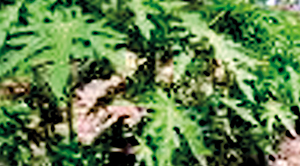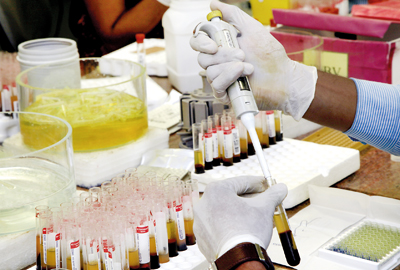News
Guinea pig rats fed papaya leaf juice concentrate show intriguing results
By Kumudini HettiarachchiRat-tests at the University of Colombo’s Department of Zoology have established a strong link between a “significant” platelet count rise and the juice-concentrate of a particular variety of papaya leaf.The research also found that rats given the leaf-concentrate recorded an increase not only in white blood cells (WBC) but also red blood cells (RBC), with no “side-effects” of harm to them, the Sunday Times learns.
However, these are only studies on rats and not on humans, stressed Chair and Senior Professor W.D. Ratnasooriya of the Department of Zoology, hastening to reiterate that they were not dengue-stricken rats.

The Red Lady papaya leaf
The research involving rats and the papaya leaf juice-concentrate, supervised by Zoology Professor Preethi Udagama and Prof. Ratnasooriya, will be submitted to a peer-reviewed international scientific journal for publication, it is learnt.
The research consists of a dissertation on the ‘Effect of Carica papaya leaf-concentrate on rat platelet count’ for a Master’s degree of Science in Cellular and Molecular Immunology by Achini Sulochana Gammulle.
The other part of the study is the effects of the leaf-concentrate on the blood vessels of the rats. The work on the dissertation has been funded by the Institute of Biochemistry, Molecular Biology and Biotechnology of the Colombo University and the other by the Zoology Department itself. The research had also been assisted by Chamini Kanathiwela, Charmaine Fernando and Nanthini Naga along with Technical Officer J.R.A.C. Jayakody. The facilities of the Zoology Department had been used throughout.
The leaf-concentrate was from the papaya variety, ‘Red Lady’, says Prof. Udagama, smilingly adding that the leaves were from trees in Achini’s home-garden at Ganemulla.
She then explains how the leaf-concentrate was taken. The veins and the petiole of the Carica papaya leaves selected for the tests were removed, the leaf-blades ground in a blender, without any water, and the mucilaginous (with mucus) juice concentrate manually separated (like squeezing coconut milk) from the leaf-residue.
After literature reviews which specified that the human dose of the leaf-concentrate for an adult should be 20ml (two tablespoons) daily for three days, the researchers had worked out the equivalent dose for the rats. After that they had decided that half that dose would be considered a “low” dose and double that a “high” dose, the Sunday Times learns.
As there is grave danger in causing a platelet-rise in a mouse with no illness, as too many platelets had a tendency to cause clotting of the blood leading to death, the researchers had come up with a “rat model”. Unlike in humans, whose platelet count should be between 150,000 and 450,000/per microlitres, the counts in the healthy rats in the study had ranged from 250 million to 400 million per ml of blood.
Usually, a lower production of platelets than the normal numbers in the bone marrow is a condition called thrombocytopenia and is associated with disorders such as leukaemia, immune system malfunction or medication side-effect, Dr. Udagama says.
“In this rat model, most likely a first in the world, 1/10th of the human equivalent dose of the drug hydroxyurea was given to rats to cause a drop in their platelet count,” she explains.

Achini Sulochana Gammulle
Thirty-six rats in all were used in the experiments, including the controls, the Sunday Times understands. (See graphic for test results) After recording a platelet count increase, the researchers had questioned how it could have happened. Usually the last part of the platelet-synthesis in the bone marrow takes about 4-6 days, says Dr. Udagama, but we saw a rise in the platelet count 24 hours after the administration of the concentrate to the rats. Therefore, it could not have been due to the manufacturing process.
About one-third of the platelets are also stored in the spleen to be released when necessary under normal healthy conditions, the researchers knew. So was there “something” in the leaf-concentrate that triggered the spleen to do so, they wondered.
Prof. Ratnasooriya then guided the researchers in testing for acute toxicity of the group of platelet-depleted rats given a high-dose of mature leaf-concentrate and found:
- No overt signs of toxicity such as salivation, yellowing of fur, lethargy, diarrhoea, tremors or behavioural changes. The group had been similar to the control group not given the concentrate.
- No reduction in body weight.
- No haematoxicity when blood counts and packed-cell volume were checked.
- No hepatotoxicity when liver function was tested through SGOT and SGPT.
- No renotoxicity when blood urea and blood creatinine were tested.
- No neurotoxicity when checking the nervous system.
- No change in the weight of internal organs.
However, we don’t know chronic toxicity as these rats were only given the doses for three days, says Prof. Ratnasooriya.
These zoologists had also gone a step further. Although these were not dengue-affected rats, they had checked vascular permeability as well as cell membrane stability, factors on which plasma leakage from blood vessels is dependent and also checked whether the leaf-concentrate had anti-inflammatory properties.
Dealing with how they carried out the experiments, Prof. Udagama says that acetic acid was administered to normal rats to induce vascular permeability after which they were given a high dose of mature leaf-concentrate along with a blue dye.
The permeability was “significantly reduced” by the concentrate in these rats resulting in a reduction of plasma leakage from the vessels, compared to the control group treated with water, the researchers have found.
The membrane stability tests done in-vitro (outside the body) also indicated significantly increased stability, as opposed to the control group.
Meanwhile, using the standard model carrageenan-induced paw oedema (paw swelling), the researchers who were testing the anti-inflammatory properties had found that the high dose of leaf concentrate had a suppressive effect on the swelling.
While urging that doctors would need to do scientific studies on humans and papaya leaf-concentrate, both Prof. Udagama and Prof.Ratnasooriya will not rest on their laurels. “Much more work needs to be done,” points out Prof. Udagama, explaining that they have worked with only the ‘Red Lady’ variety of papaya.
What of our local varieties – will we get similar results, she asks, curious also about other parts of the papaya tree such as the fruit.
Even from the research done so far, a burning question that keeps them up at night is what active ingredient or ingredients in the leaf concentrate is producing these wonderful results.
For that, the team at Colombo’s Zoology Department will not only need encouragement and support but also funding.
Majority of dengue patients could recover with present methods: Dengue specialist
The current treatment methods including fluid therapy for dengue is very much good enough to manage the disease and 99.9% of patients who walk into hospital with a platelet count just above 100,000/microlitre will recover without the help of papaya leaf-concentrate, stressed Dengue Specialist Dr. LakKumar Fernando when contacted by the Sunday Times.
If the leaf-concentrate increases the platelet count without equally reversing all other effects of the disease to the same intensity, it can confuse the clinicians whose treatment of dengue will be based on the up and down trends of platelets. Presently as knowledge on the issue is still limited, the administration of the leaf concentrate can do more harm than good, he reiterated.
Citing the case of an eight-month-old bought in with DHF, whose platelet count below 10,000/m, and with clear leaking, this paediatrician attached to the Negombo Hospital said his team managed the child very well in the ward and not even in an ICU. The baby was doing fine when the Sunday Times visited the hospital last week. Dr. Fernando has treated more than 200 children suffering from Dengue Haemorrhagic Fever including many who had gone into shock, transferred to his ward at the last minute, and pulled them from the jaws of death, within the last six months.
Referring to capillary permeability, he said the issues surrounding it are complex, unknown and not fully explained to-date. The possible mediators that affect these mechanisms are also not identified, he said, questioning why fluid leakage occurs only into the pleural (chest) and peritoneal (abdominal) cavities. The reason is still unknown.
Therefore, the effects of simple capillary permeability cannot be extrapolated to capillary permeability in dengue which is a complex matter, he added.
Dengue Fever (DF) and Dengue Haemorrhagic Fever (DHF) are not diseases of the platelets, he said. Anyone who gets DF will recover anyway if there are no other illnesses, whether an increase in the platelet count is stimulated or not. But DHF is deadly and needs fluid therapy under conditions which are strictly monitored in a hospital, Dr. Fernando added.
The bitter liquid may cause gastritis
A problem, according to Prof. Ratnasooriya, is that the leaf-concentrate is difficult to drink as it is very bitter and could cause gastric irritation followed by vomiting.
Rats don’t vomit as they don’t have a vomit centre, he says, adding that they were not able to check that out. Whether the leaf-concentrate will cause gastric lesions will also need to be verified.
In dengue patients gastric erosion could cause serious consequences, the Sunday Times understands.
comments powered by Disqus















